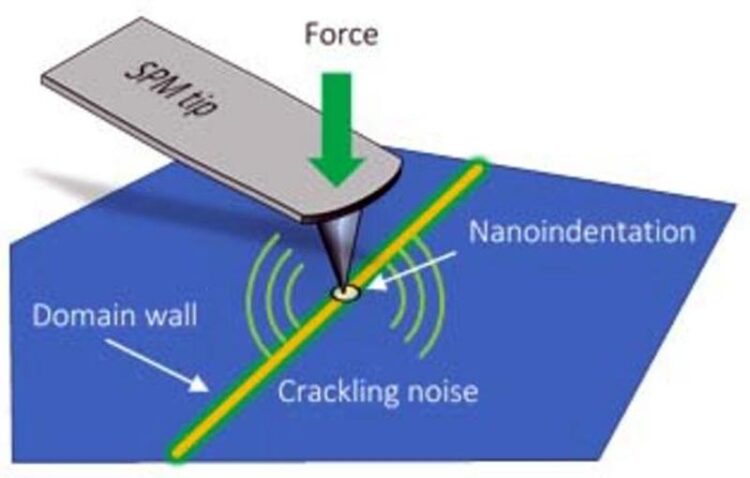Listening to nanoscale earthquakes

Crackling noise microscopy detects nanoscale avalanches in materials using a scanning probe microscope (SPM) tip.
Credit: FLEET
Crackling noise of atoms shifting at nanoscale key to understanding novel materials for future electronics.
A recent UNSW-led paper published in Nature Communications presents an exciting new way to listen to avalanches of atoms in crystals.
The nanoscale movement of atoms when materials deform leads to sound emission. This so-called crackling noise is a scale-invariant phenomenon found in various material systems as a response to external stimuli such as force or external fields.
Jerky material movements in the form of avalanches can span many orders of magnitude in size and follow universal scaling rules described by power laws. The concept was originally studied as Barkhausen noise in magnetic materials and now is used in diverse fields from earthquake research and building materials monitoring to fundamental research involving phase transitions and neural networks.
The new method for nanoscale crackling noise measurements developed by UNSW and University of Cambridge researchers is based on SPM nanoindentation (see figure).
“Our method allows us to study the crackling noise of individual nanoscale features in materials, such as domain walls in ferroelectrics,” says lead author Dr Cam Phu Nguyen. “The types of atom avalanches differ around these structures when the material deforms.”
One of the method’s most intriguing aspects is the fact that individual nanoscale features can be identified by imaging the material surface before indenting it. This differentiation enables new studies that were not possible previously.
In a first application of the new technology the UNSW researchers have used the method to investigate discontinuities in ordered materials, called domain walls.
“Domain walls have been the focus of our research for some time. They are highly attractive as building blocks for post-Moore’s law electronics,” says author Prof Jan Seidel, also at UNSW. “We show that critical exponents for avalanches are altered at these nanoscale features, leading to a suppression of mixed-criticality, which is otherwise present in domains.”
From the perspective of applications and novel material functionalities, crackling noise microscopy presents a new opportunity for generating advanced knowledge about such features at the nanoscale. The study discusses experimental aspects of the method and provides a perspective on future research directions and applications.
The presented concept opens the possibility of investigating the crackling of individual nanoscale features in a wide range of other material systems.
THE STUDY
The paper Crackling noise microscopy was published in Nature Communications on 16 August 2023 (Cam-Phu Thi Nguyen, Peggy Schoenherr, Ekhard K. H. Salje, and Jan Seidel, DOI: 10.1038/s41467-023-40665-4).
The authors acknowledge funding from the Australian Research Council (Discovery, LIEF and Centre of Excellence programs).
Journal: Nature Communications
DOI: 10.1038/s41467-023-40665-4
Method of Research: Experimental study
Subject of Research: Not applicable
Article Publication Date: 16-Aug-2023
Media Contact
Errol Hunt
ARC Centre of Excellence in Future Low-Energy Electronics Technologies
errol.hunt@monash.edu
Office: 042-313-9210
Media Contact
All latest news from the category: Materials Sciences
Materials management deals with the research, development, manufacturing and processing of raw and industrial materials. Key aspects here are biological and medical issues, which play an increasingly important role in this field.
innovations-report offers in-depth articles related to the development and application of materials and the structure and properties of new materials.
Newest articles

Simplified diagnosis of rare eye diseases
Uveitis experts provide an overview of an underestimated imaging technique. Uveitis is a rare inflammatory eye disease. Posterior and panuveitis in particular are associated with a poor prognosis and a…

Targeted use of enfortumab vedotin for the treatment of advanced urothelial carcinoma
New study identifies NECTIN4 amplification as a promising biomarker – Under the leadership of PD Dr. Niklas Klümper, Assistant Physician at the Department of Urology at the University Hospital Bonn…

A novel universal light-based technique
…to control valley polarization in bulk materials. An international team of researchers reports in Nature a new method that achieves valley polarization in centrosymmetric bulk materials in a non-material-specific way…





















